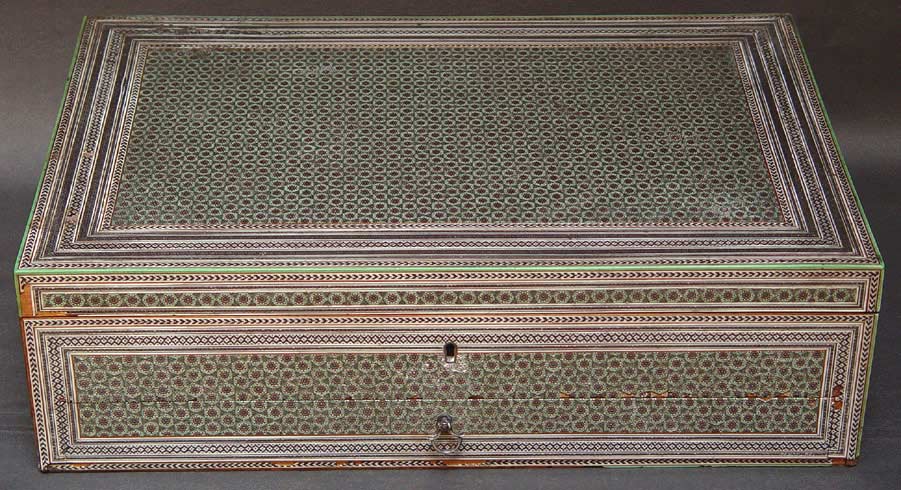Boxes
Collection IndexSlope Workbox
Bombay Presidency
Workbox with writing Slope
- 13 x 43.5 x 28.5 cms
1800 - 1814
Micromosaic inlay (sadeli) on a rosewood carcass with sandalwood lining;
fitted interior with ivory & silver fittings.
A letter accompanying this box states that this was a gift from William Boyce
Merchant in Bombay in 1814 to Richard Lovell Edgeworth.
He corresponded with Richard Lovell Edgeworth and invented a visual or optical
telegraph line in, which extended over 400 miles from Calcutta to Chunar.
The first attempt at visual signalling making use of alphabets was the semaphore
telegraph developed in 1792 by Claude Chappe, who established a system comprising
twenty-two stations between Lille and Paris, known as the ‘tachygraphs’.
Four years later the Admiralty approved the construction of a ‘semaphore'
system developed by George Murray between London and Portsmouth. In 1813 William
Boyce submitted a plan for establishing a telegraph system across the Peninsula
of India. The plan was to construct two routes, one linking Bombay to Calcutta
and the other from Bombay to Madras. Boyce was summoned to Calcutta in 1816
and asked to construct an experimental line between Fort William and Barrackpore.
In 1817 the Government approved the construction of a telegraph line from
Calcutta to Chunar.
Richard Lovell Edgeworth (31 May 1744 – 13 June 1817) was an Anglo-Irish
politician, writer and inventor.
Edgeworth was born in Pierrepont Street, Bath, England, great-grandson of
Sir Salathiel Lovell through his grand-daughter, Jane Lovell.
A Trinity College, Dublin and Oxford alumnus, he is credited for creating,
among other inventions, a machine to measure the size of a plot of land. He
also made strides in the developing educational methods. He anticipated the
caterpillar track with an invention that he played around with for forty years
but that he never successfully developed.[2] He described it as a "cart
that carries its own road".
He married Frances Beaufort, older sister of Francis Beaufort of the Royal
Navy. The two men installed a telegraph line for Ireland.
Richard Lovell Edgeworth was a member of the Lunar Society. The Lunar Society evolved through various degrees of organization over a period of years, but was only ever an informal group. No constitution, minutes, publications or membership lists survive from any period, and evidence of its existence and activities is found only in the correspondence and notes of those associated with it. Dates given for the society range from sometime before 1760 to it still operating as late as 1813.
Fourteen individuals have been identified as having verifiably attended Lunar Society meetings regularly over a long period during its most productive time: these are Matthew Boulton, Erasmus Darwin, Thomas Day, Richard Lovell Edgeworth, Samuel Galton, Jr., James Keir, Joseph Priestley, William Small, Jonathan Stokes, James Watt, Josiah Wedgwood, John Whitehurst and William Withering.

